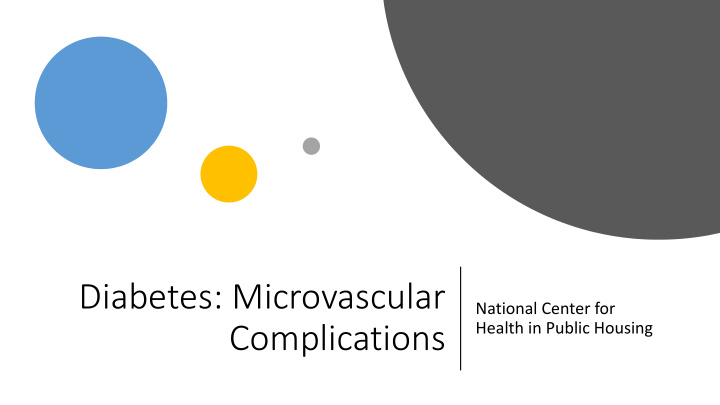



Diabetes: Microvascular National Center for Complications Health in Public Housing
Diabetes in PHPC Settings Percentage of Patients with Diabetes served by PHPCs 9.2 9.1 9.2 8.83 8.64 8.72 9 8.66 8.67 8.8 8.42 8.6 8.4 8.2 8 2012 2013 2015 2016 All Health Center Programs Public Housing Primary Care
Percentage of Patiens with Uncontrolled Diabetes in PHPC Settings 32% HBA1c>9 in PHPC Settings 68% HbA1c>9 HbA1c<9
Barriers to Successful Management of Diabetes • Clinical limitations • Clinical inertia • Underutilization of team support • Treatment nonadherence: *psychosocial *environmental *interpersonal *socioeconomic *treatment-related
Diabetes Self- Management Education and Support
Diabetes Programs and Initiatives
Diabetic Kidney Disease • Screening At least once a year assess urinary albumin and eCGR in patients with type 1 diabetes with duration of >5years, in all patients with type 2 diabetes, and in all patients with comorbid hypertension
Diabetic Retinopathy • Screening o Adults with type 1 diabetes should have an initial dilated and comprehensive eye examination within 5 years after the onset of diabetes o Patients with type 2 diabetes should hae an initial dilated and comprehensive eye examination at the time of diagnosis o Subsequent dilated retinal examinations should be repeated at least annually
Diabetic Neuropathy • Screening All patients should be assessed for diabetic peripheral neuropathy starting at diagnosis of type 2 diabetes and 5 years after diagnosis of type 1 diabetes and at least annually thereafter
Diabetes & Foot Care • Recommendations o Perform a comprehensive foot evaluation at least annually to identify riks factors for ulcers and amputations o All patients with diabetes should have their feet inspected at every visit o Patients with symptoms of claudication or decreased or absent pedal pulses should be referred for ankle-brachial index and for further vascular assessment as appropriate
Recommend
More recommend